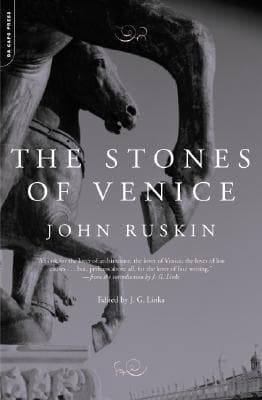
Book Review Summary: The Stones of Venice
Introduction
"The Stones of Venice" by John Ruskin is a seminal work that explores the architectural history and beauty of the city of Venice. Ruskin, a prominent Victorian art critic, delves into the intricacies of Gothic and Renaissance architecture, offering a unique perspective on the artistic and cultural significance of Venice. This article will provide an overview of the book, introduce the author, analyze readers' views, and summarize the reasons for both recommending and not recommending this book.
About John Ruskin
John Ruskin (1819-1900) was an English writer, art critic, and philosopher who shaped Victorian artistic taste through his influential books. "The Stones of Venice" is one of his most celebrated works, published in three volumes between 1851 and 1853. Ruskin's passion for art and architecture is evident in his writing, as he delves into the aesthetics and cultural significance of Venice's architectural heritage. His deep knowledge and understanding of architectural form, function, style, and history have made him a revered figure in the field.
Analysis of Views
-
Architectural Appreciation: Readers who appreciate architecture and design find "The Stones of Venice" to be a fascinating exploration of Venice's architectural history. Ruskin's detailed descriptions and analysis of various architectural elements, such as arches, buttresses, walls, and ornamentation, provide a deep understanding of the city's built environment.
-
Cultural Significance: The book also resonates with readers who appreciate the cultural significance of Venice. Ruskin delves into the historical context of Venice's architecture, highlighting its role in shaping the city's identity and reflecting its political, religious, and artistic aspirations. He offers insights into the city's evolution from a Gothic to a Renaissance style, shedding light on the cultural shifts that occurred during this period.
-
Lyrical Writing Style: Ruskin's writing style is praised for its lyrical quality. His descriptions evoke a sense of wonder and awe, transporting readers to the heart of Venice's architectural beauty. Readers appreciate his ability to convey the emotional and spiritual dimensions of architecture, making the book not just informative but also engaging and inspiring.
-
Renaissance vs. Gothic Debate: Some readers find Ruskin's vehement argument against Renaissance architecture intriguing. He presents a compelling case for the superiority of Gothic architecture, citing its organic forms, accommodation of individual workmen's skills, and its ability to channel the thoughts of worshippers toward God. This debate sparks interesting discussions among readers who have varying opinions on the merits of different architectural styles.
-
Limited Recommendation: A few readers find "The Stones of Venice" challenging due to its length and density. Some find it overwhelming or difficult to follow, especially those who are not particularly interested in architecture or have limited time to devote to reading. These readers recommend focusing on specific sections or abridged versions to fully appreciate Ruskin's insights without getting bogged down by excessive detail.
Reasons for Recommendation
-
Architectural Insights: Readers recommend "The Stones of Venice" for its in-depth exploration of Venice's architectural history and design principles. Ruskin's comprehensive analysis provides valuable insights into the city's built environment, allowing readers to appreciate its architectural beauty on a deeper level.
-
Cultural Context: The book's cultural significance is another reason for recommending it. Ruskin delves into the historical context of Venice's architecture, shedding light on how it reflects the city's political, religious, and artistic aspirations. Readers appreciate this broader perspective on Venice's architectural heritage and find it enriching.
-
Lyrical Writing Style: Ruskin's lyrical writing style is widely praised for its ability to evoke emotions and transport readers to Venice's architectural beauty. Readers appreciate his ability to convey the spiritual dimensions of architecture, making the book not just informative but also engaging and inspiring.
Reasons for Not Recommendation
-
Length and Density: Some readers find "The Stones of Venice" challenging due to its length and density. They recommend focusing on specific sections or abridged versions to fully appreciate Ruskin's insights without getting overwhelmed by excessive detail.
-
Renaissance vs. Gothic Debate: While some readers find Ruskin's argument against Renaissance architecture intriguing, others find it controversial or too extreme. They may not share his views on the superiority of Gothic architecture or find his arguments overly dogmatic. These readers may prefer books that present a more balanced perspective on architectural styles.
Conclusion
"The Stones of Venice" by John Ruskin offers a comprehensive exploration of the architectural history and beauty of Venice. Through his detailed descriptions and analysis of various architectural elements, Ruskin provides valuable insights into the city's built environment and sheds light on its historical context. While some readers find the book challenging due to its length and density or disagree with Ruskin's views on Renaissance architecture, others appreciate its architectural insights and cultural significance. Whether you are an architecture enthusiast, a lover of Venice, or simply seeking fine writing, "The Stones of Venice" is a book that offers a rewarding journey through the city's architectural heritage.